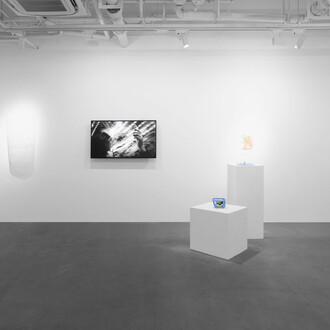When you step into the grove, all you see are trees, not the woods.
Wang Jun's work in recent years has emphasized a conscious theory of practice, Sketching, as a method of production (creation), and the woods as a place to “dwell”. In the spring of 2018, Wang Jun stepped into his destined woods for the first time, and picking up a paintbrush in the woods wouldn't happen until a few months later in the fall. Earlier in 2017, the artist had just completed a major phase of his work, Three days, three nights-1#, and some new propositions became clear in his subsequent practice: Embodiment, Traces, and Specific Sites.
No matter how you look at it, talking about Off the beaten track has to start with Three days, three nights- specifically the third iteration of the project that takes place in late 2019 in the Dong village of Huanggang in Liping County, Southeast Guizhou1. It was in the project practice of using the public space of the ethnic minority villages as a specific field that the artist re-recognized the potential of Sketching and place.Sketching is an encounter that requires the return of the body to a specific site, a kind of physical projection on the site2. The potential that this influence inspires is all-encompassing. Local history, field, personal memory and emotion, art ontology, walking and mobility, and multi-dimensional writing are beginning to be actively emphasized and invited by artists.
In the woods, an encounter; in the woods; a trace; in the woods, a way.
“Paradoxically, the world deep in the woods is the most open to our perceptions”, when Tim Ingold talks about the woods, he reminds us to be wary of the usual arrogant human perspective from above, and Lefebvre's Bird’s-eye view- not staring at the trees, but wandering among them, making the trees slightly sway and gently caress the surface. Also, Finnish architect Juhani Pallasmaa once pointed out Eyes of the skin- the eyes can gently caress the surface, outline and edge of things. To dwell in the world is to participate in the process of formation. To dwell in the world is to participate in a dynamic world full of energy, force and flow3.
Here’s a complete series of the works. I collectively refer to it as the Woods image series, because it is created through the artist's lingering in the woods, various direct sketches (of different styles), blind paintings, on-site action paintings, sketch notes, as well as the Copy exercise in the studio4. Wang continuously writes about a single theme over a long period of time through various media, and stimulates expression through various "limitations". For instance, he would walk into the woods around dusk, perceive spirituality and paint until the night was dark and he was tired. Sometimes, the artist is a territorial ranger, wandering and lingering freely and joyfully through the woods, subtly observing the slow changes of seasons or time in the woods. More often than not, he is like a sentient being who, through his brush and words, records, sketches, interprets and translates the Doppler effect of a certain moment5. The woods is constantly activated and discovered during Wang Jun's tour. Certainly, it has always been there. However, when the Bird’s-eye view and the Eye of the skin look directly at each other, you and I in the woods coexist, dwelling in the world.
(Text by Ni Kun May 25th, 2025)
Notes
1 Three days, three nights is an event art project initiated and implemented by artist Wang Jun, which was carried out in Organhaus, Chongqing (2017), Institute for Provocation, Beijing (2018), and Huanggang Village, Liping County, Guizhou Province (2019). The project begins with a reflection on the image and authenticity (authorship) of painting, integrating multiple elements such as action painting, happening, drama, and event art. Meanwhile, as the project space actively expands from the white box into public social Spaces, the works gradually shift towards and present the characteristics of art in specific fields.
2 Text from Wang Jun, Eve, sketching, and the generation of methods, in Art monthly, vol. 8, 2020.
3 Text from Tim Ingold, Making: anthropology, archaeology, art and architecture, Jiangsu Phoenix Fine Arts Publishing LTD., 2013. Print. p. 135.
4 Since 2011, Wang Jun has embarked on a series of paintings titled Copy exercise. Through repeated copying of specific parts of the canvas, these works ultimately question the "concrete and abstract", "real and false" aspects of images in an abstract painting style.
5 This is a term in physics. The doppler effect refers to the fact that when the wave source or the observer moves, the frequency of the wave received by the observer changes.











